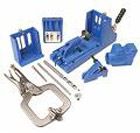We may be compensated if you purchase through links on our website. Our team is committed to delivering honest, objective, and independent reviews on home products and services.
Project details
Skill
Cost
Estimated Time
Installing a sliding barn door can add rustic charm and functionality to any home, particularly in tight spaces where a traditional swinging door may not be suitable. This DIY project allows you to customize your door’s appearance and size and cut down on installation costs. In this segment, This Old House Senior Technical Editor Mark Powers takes us through the process of constructing and installing your own sliding barn door.
*Cost data sourced from Angi
Tools and Materials for Building a Sliding Barn Door
You’ll need the following tools and materials to install a sliding barn door:
Tools
- Bar clamps and speed clamps
- Combination square
- Drill/driver
- Level
- Miter saw
- Pneumatic nailer
- Pocket hole jig
- Random orbit sander
- Stud finder
- Tape measure
- Woodworking hammer
Materials
- 1×3 strapping for blocking
- 1×4 pine for mounting rail
- 1×5 pine for filler strips
- 1×6 cedar for face frame
- 1×6 pine boards for the door back
- Pallet boards or reclaimed wood
- Paste wax for finishing
- Rolling hardware for barn doors
- Screws (deck screws and pocket hole screws)
- Sliding barn door hardware kit
- Wood glue and panel adhesive
Step-by-Step Guide to Installing a Sliding Barn Door
Follow the steps below to complete your sliding barn door installation.
Overview
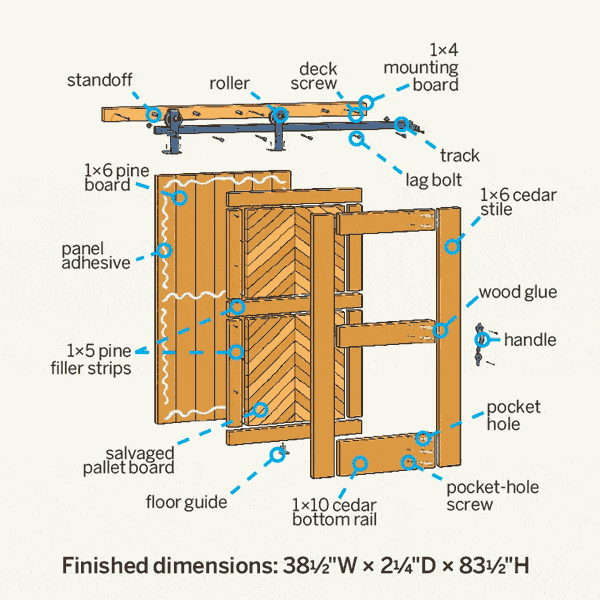
Plan for a two-day project, as follows:
- Day 1: Build the door (Steps 2-10).
- Day 2: Hang the door (Steps 11-13).
Before you begin, measure the width of the door from the outside edges of the casing, then order a hardware kit with a track twice that width.
Cut List for Installing a Sliding Door
Designed to cover a 30-inch-wide opening with a 4-inch casing on either side, this door measures 38 1/2 inches wide by 2 1/4 inches thick by 83 1/2 inches tall. Take a look at the cut list below:
- 1×6 pine boards for the back: Cut the boards a half inch shorter than the height of the opening to allow the door to pass over the floor guide.
- 1×3 strapping for blocking: Cut a section of the board to the width of the work surface; ours measured 48 inches. Then cut the rest of the board into blocking.
- 1×5 pine for the filler strips: Cut three rails the width of the door; ours measured 38 1/2 inches. Then cut four stiles to fill between the rails, completing the upper and lower panels of the door. Our stiles measured 35 inches long for the upper panel and 34 inches long for the lower one, creating the 1-inch channel for the floor guide.
- Pallet boards: Assemble 60 boards at least 24 3/8 inches long, mitered to parallel 45-degree angles on each end to fit.
- 1×6 cedar for face frame: Cut two stiles the height of the door; ours measured 83 1/2 inches. Then cut four rails to span between the stiles; ours measured 27 1/2 inches. Edge-glue and clamp two of those rails together to make the bottom rail. Rip 2 inches off one edge after the glue dries.
- 1×4 pine for the mounting rail: Cut it to match the track length; ours measured 77 inches.
Step 1: Assemble the Boards

- For our 30-inch-wide opening, seven 1x6s spanned the casing perfectly. You may need to rip the pine boards to width.
- Measure from the floor to the top of the door casing, then cut the boards a half inch shorter on a miter saw.
- Gang the boards side by side, place the blocks along the outside edges, and use long bar clamps to cinch them together.
- Square up the assembly with longer strapping at the top and bottom edges.
- Screw the blocks and straps in place and remove the clamps.
Step 2: Add Filler Strips
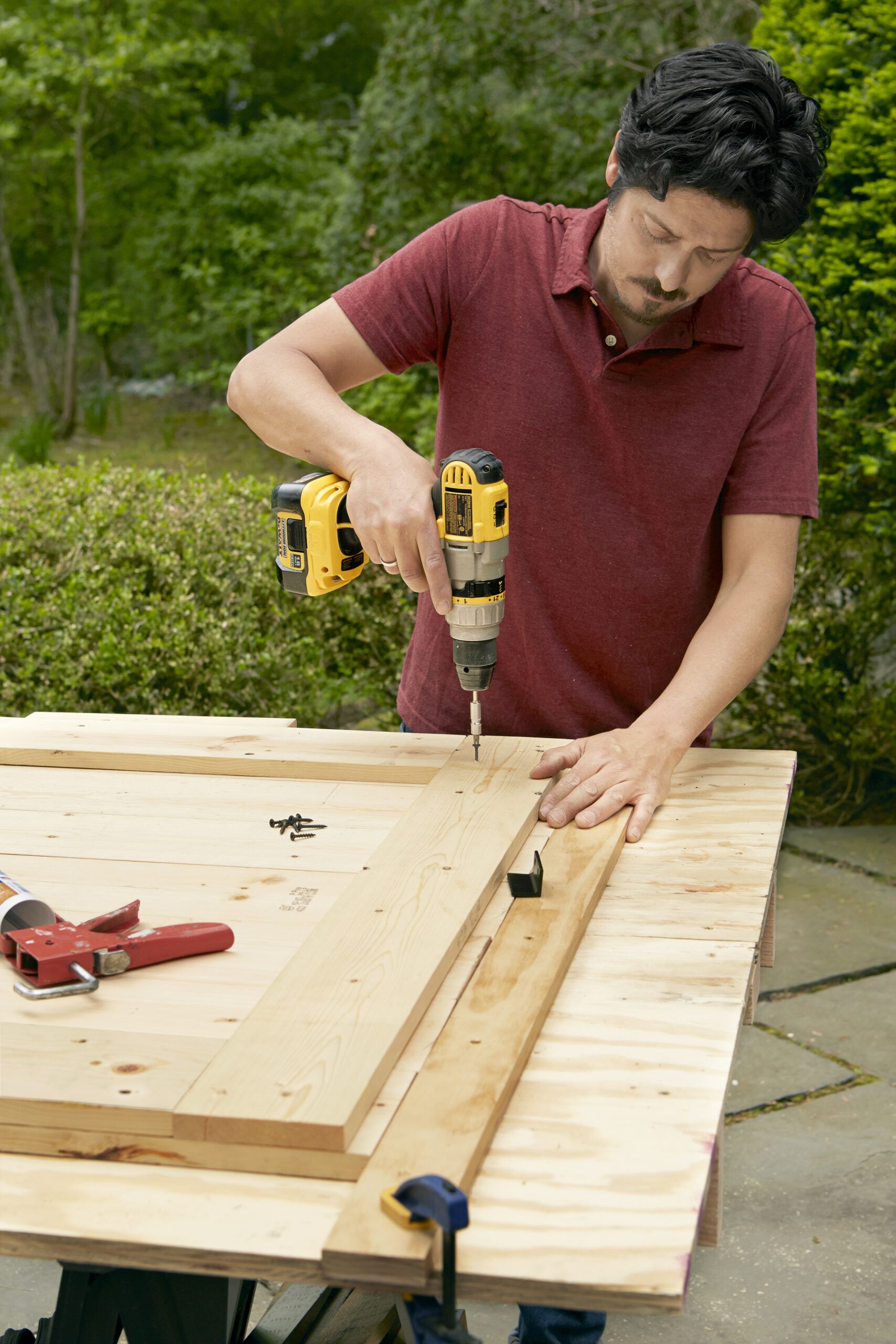
- Use a miter saw to cut the 1×5 filler strips according to the cut list.
- Add adhesive and set the top rail flush along the top of the boards. Adhere the upper stiles below it—flush to the outside edges—and the middle rail below them.
- Add the lower stiles and rail, leaving a 1-inch channel for the floor guide that contains the door.
- Drive a 1 1/4-inch deck screw through each strip into each 1×6 it crosses.
Step 3: Cut the Chevrons
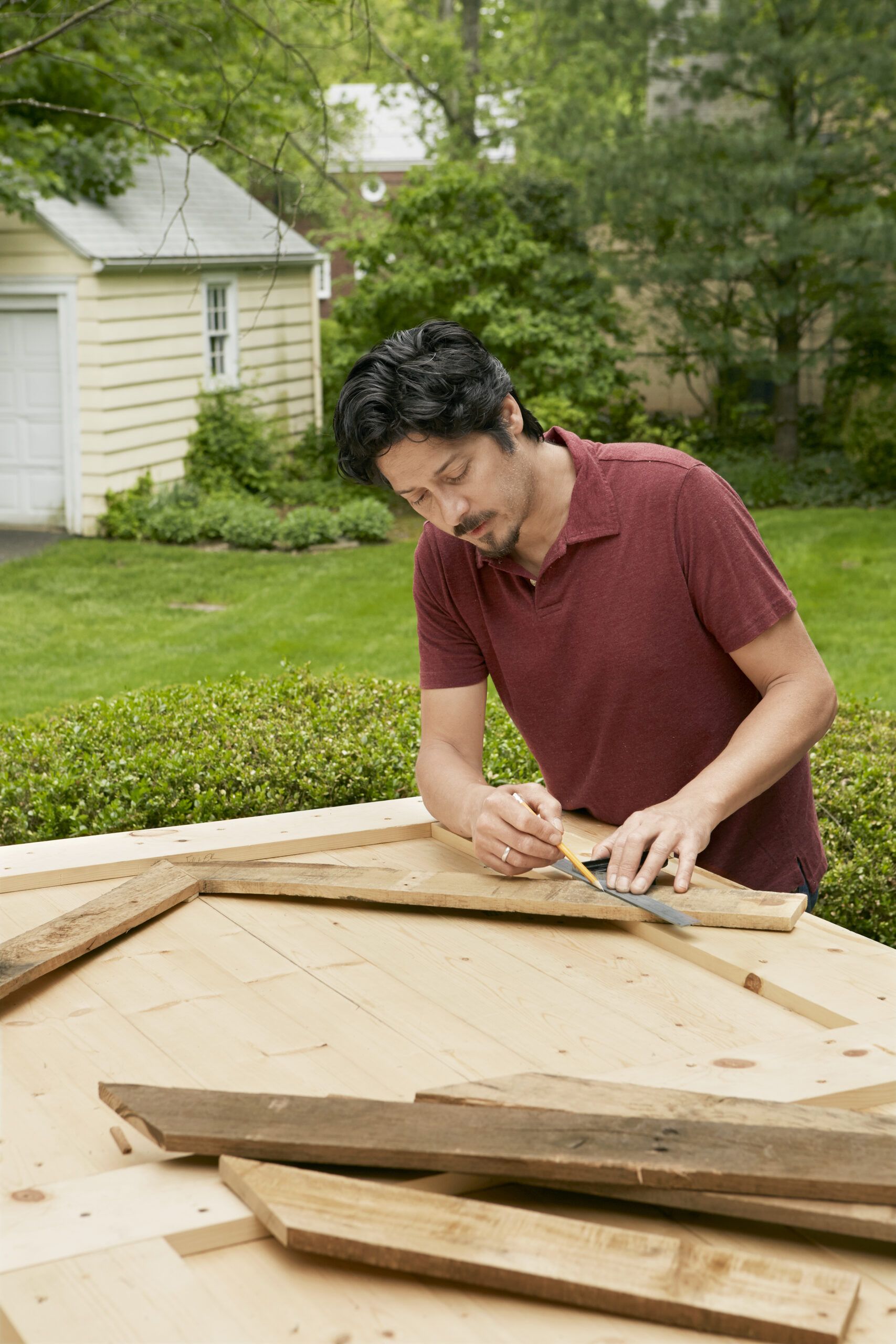
- Use a straightedge to mark a centerline down the door’s two inset panels.
- Set the miter saw to 45 degrees and cut one end off each pallet board.
- Starting at the top rail, butt the mitered ends of two pieces of similar thickness and color together at the centerline, forming an arrow.
- Use a combination square to mark the boards about 1/8 inch short of where they overlap the stiles, as shown.
- Miter the pieces to length, then dry-fit them.
- Repeat, one chevron at a time.
Step 4: Cut the Corners
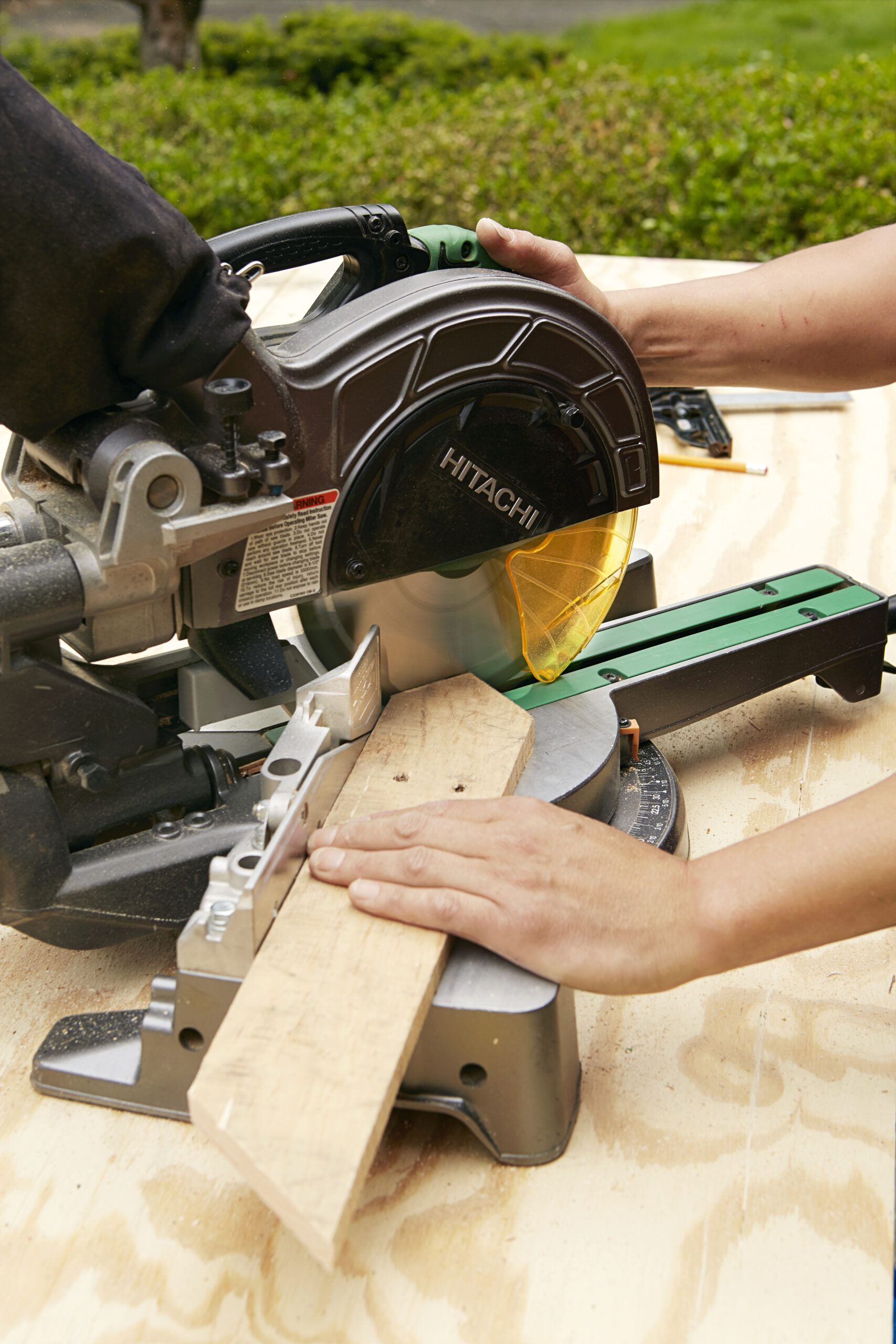
- For the boards that hit the corners, use the combination square to mark where the piece overlaps the stile and the rail.
- Cut the two angles on the miter saw as shown.
- After installing the longer pieces, fill the rest of the pattern with scrap and cut to fit.
Step 5: Install the Pattern
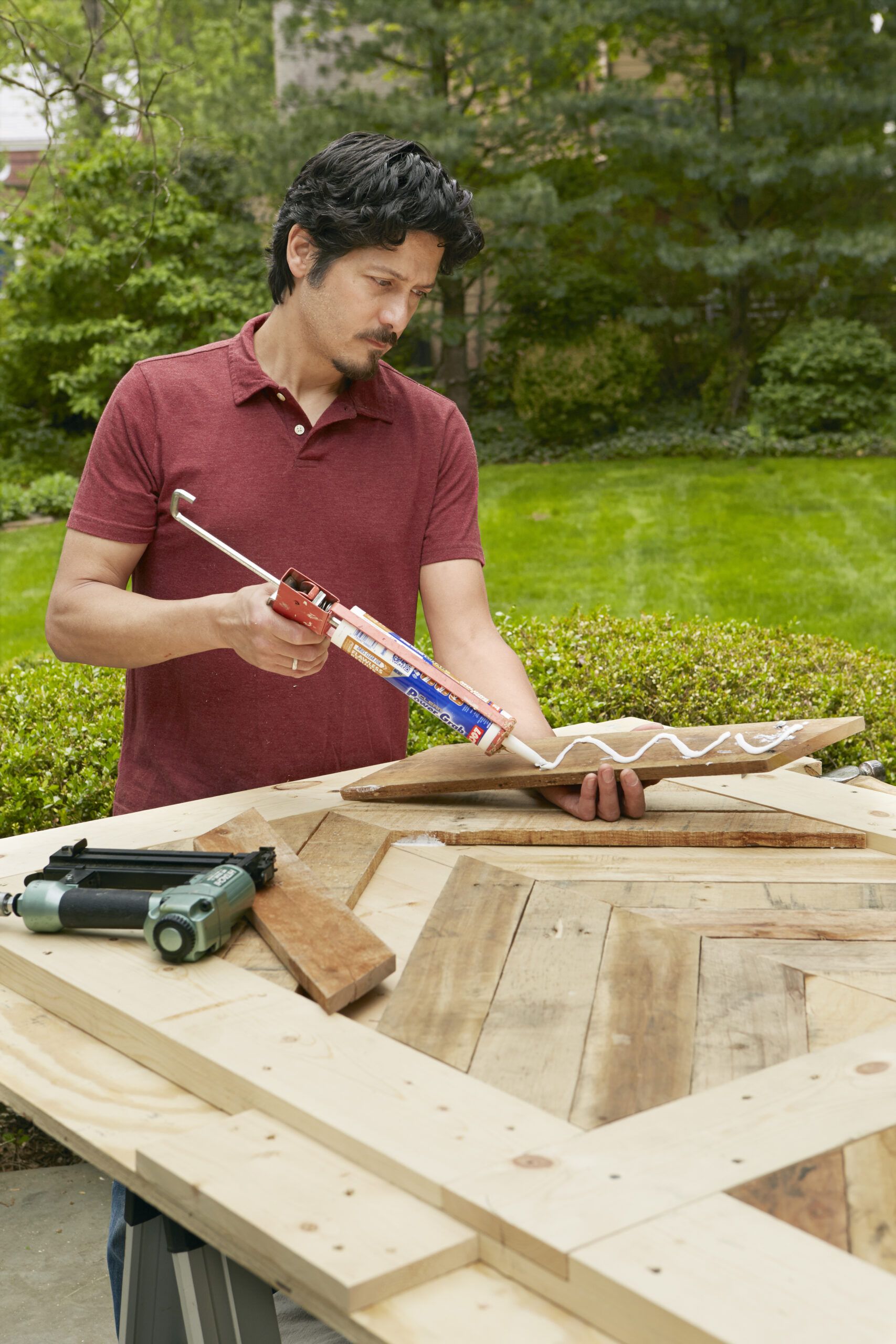
- With the chevrons dry-fit in both panels, lift out one pair of boards at a time, apply panel adhesive to the undersides, and press them back in place.
- Using a pneumatic nailer, tack the boards in place with 1 1/4-inch brads, one near each corner of each board.
- Repeat the process, adhering and nailing each pair of boards as you work down both panels.
Step 6: Drill Pocket Holes
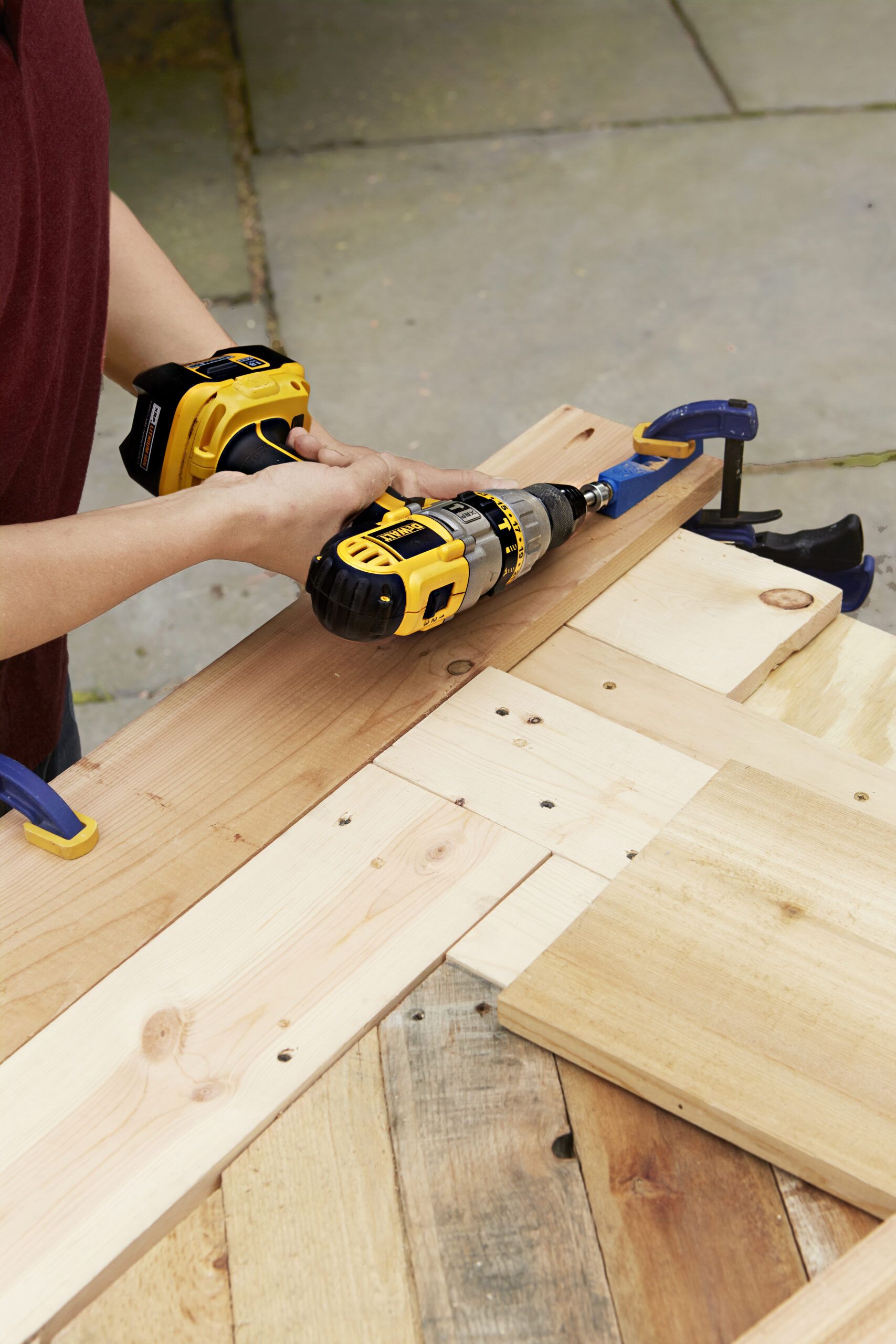
- At the miter saw, cut the cedar according to the cut list above.
- Arrange the pieces rough face down, covering the filler strips.
- Clamp a pocket hole jig at the end of a rail, even with one edge, and use the kit bit to drill a hole.
- Reset the jig along the other edge and repeat.
- Drill two pocket holes at each end of the upper and middle rails, as shown, and three at each end of the wider bottom rail.
Step 7: Build the Frame
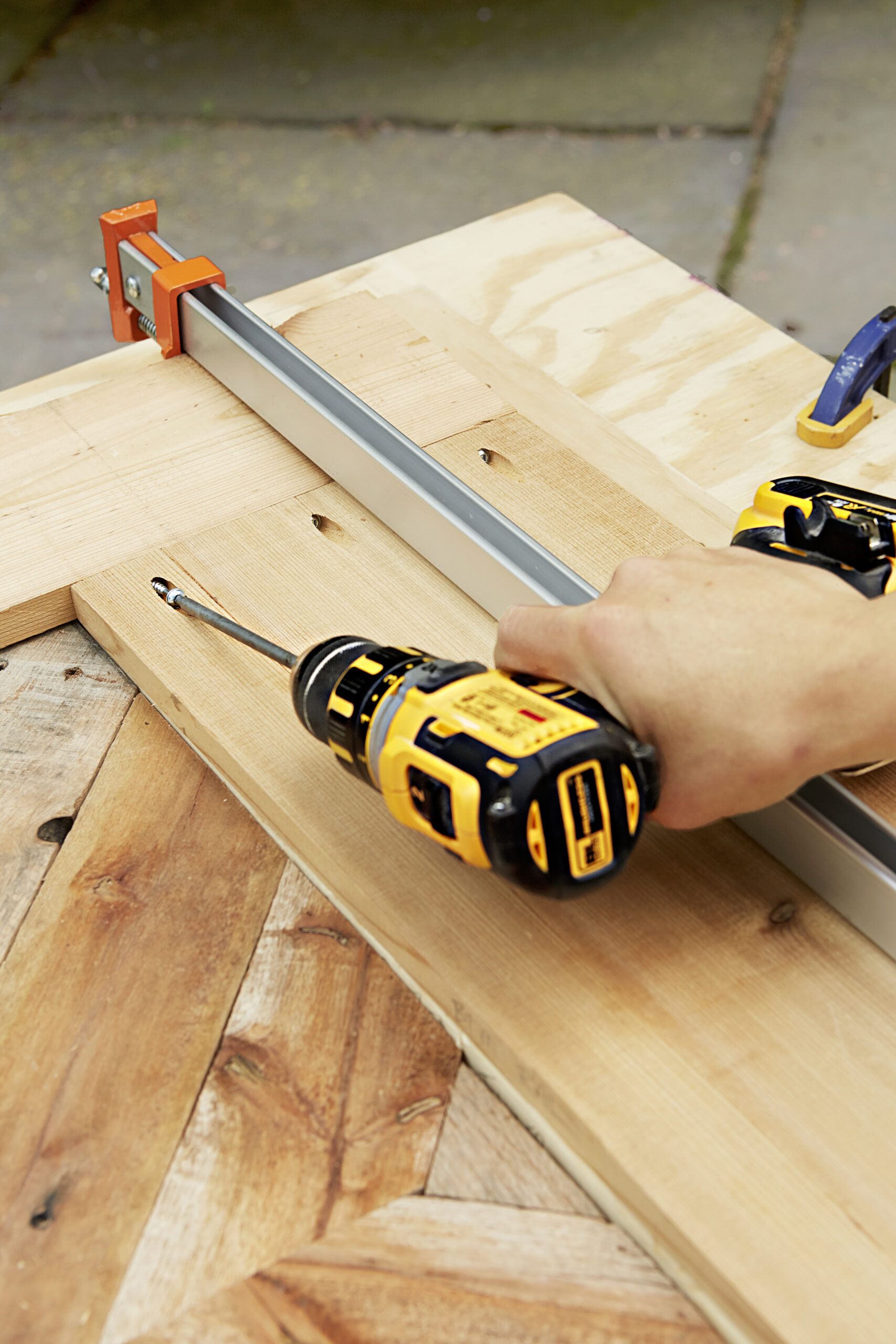
- Apply wood glue to the ends of the rails and the adjoining edges of the mating stiles, then clamp the frame together.
- Drive the screws provided with the kit into the edges of the stiles at each pocket hole, as shown.
- Remove the bar clamps.
Step 8: Attach the Face Frame

- Gently remove the face frame and set it aside.
- Apply panel adhesive in a zigzag pattern along the filler strips.
- Bring the frame back to the table and orient it rough side up, hiding the screws.
- Lay it in place as shown and align it along all four edges.
- Tack it down with 1 1/4-inch brads every 8 inches or so.
Step 9: Rub on the Finish

- Lightly sand the entire door with 100-grit paper to knock down any splinters.
- Use a cotton rag to rub a liberal amount of paste wax into the wood.
Step 10: Attach the Rollers
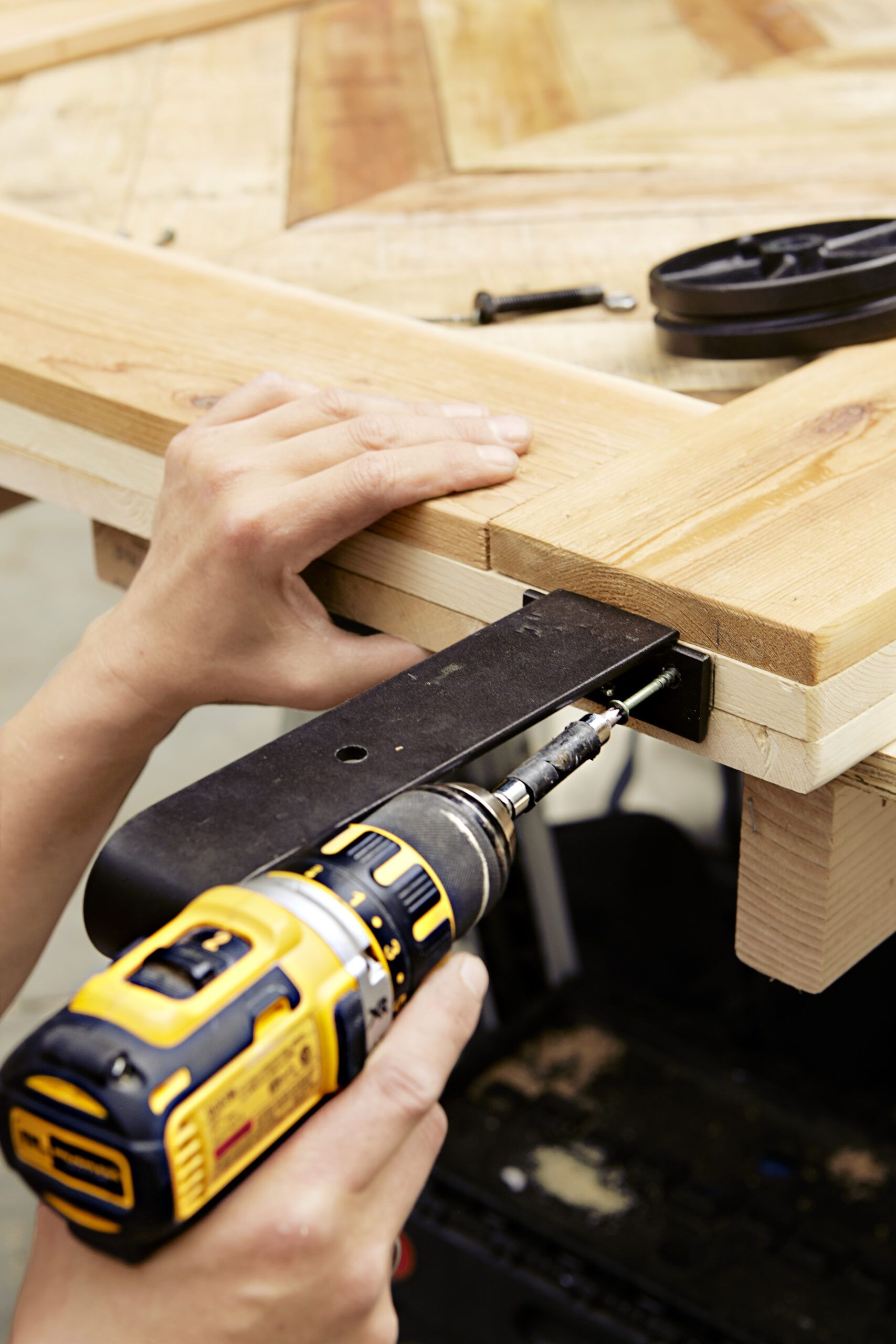
- Center the rolling hardware on the width of the cedar stiles. It may help to remove the wheels first.
- Mark the screw locations, drill pilot holes into the filler-strip edge with a 1/8-inch bit, then screw the hardware in place as shown.
- Replace the wheels and slip the track into their grooves.
- Measure between the door and the track to determine how high above the casing to mount it—it was 3/4 inch for this hardware.
Step 11: Attach the Mounting Board
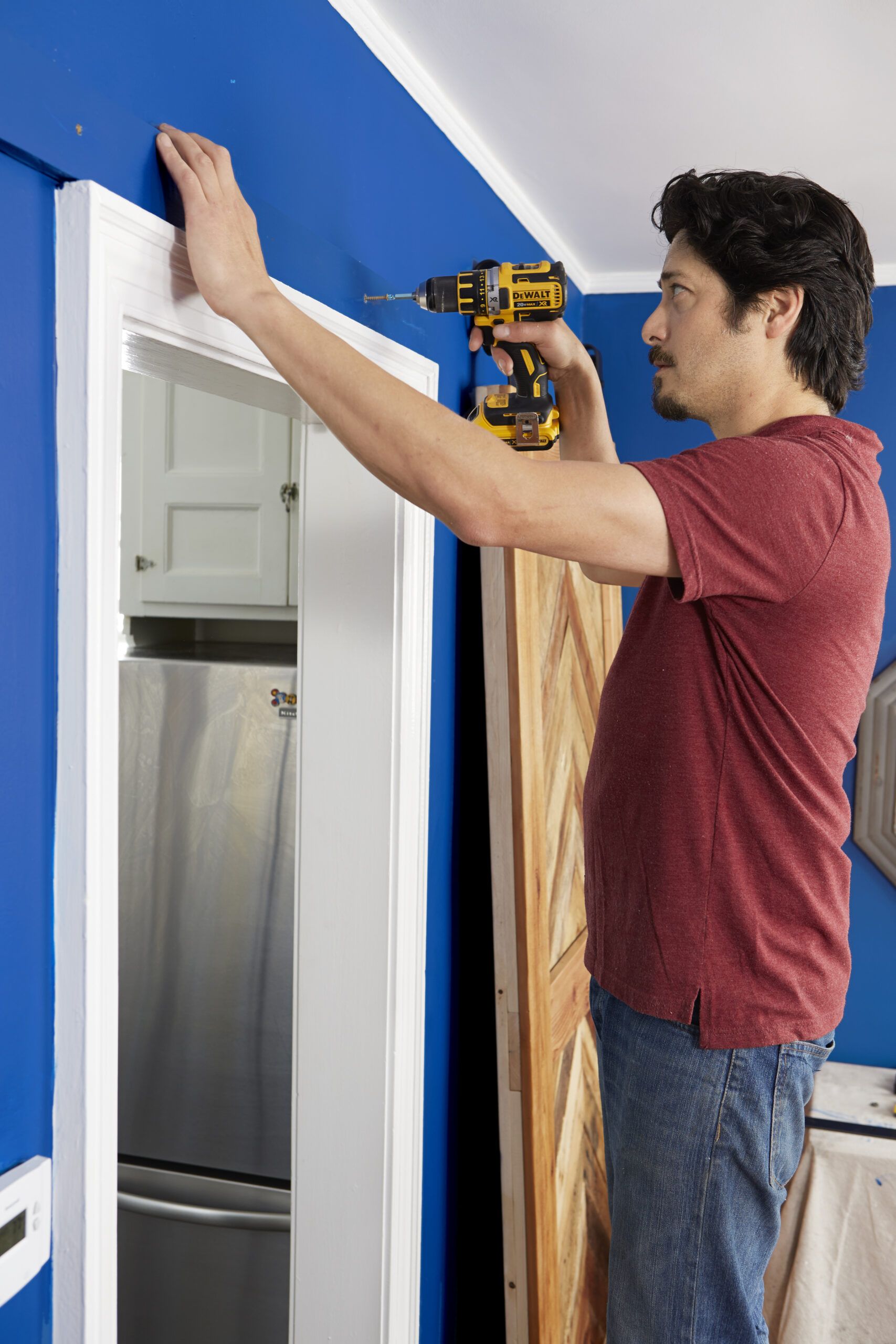
- At the miter saw, cut a length of 1×4 equal to the length of the track.
- Optional: Paint it to match the wall.
- Use a stud finder to locate the framing and mark locations above the head casing.
- Level the mounting board above the casing and drill pilot holes through it and into each stud with a 1/8-inch bit.
- Secure it with 3-inch deck screws.
Step 12: Install the Track
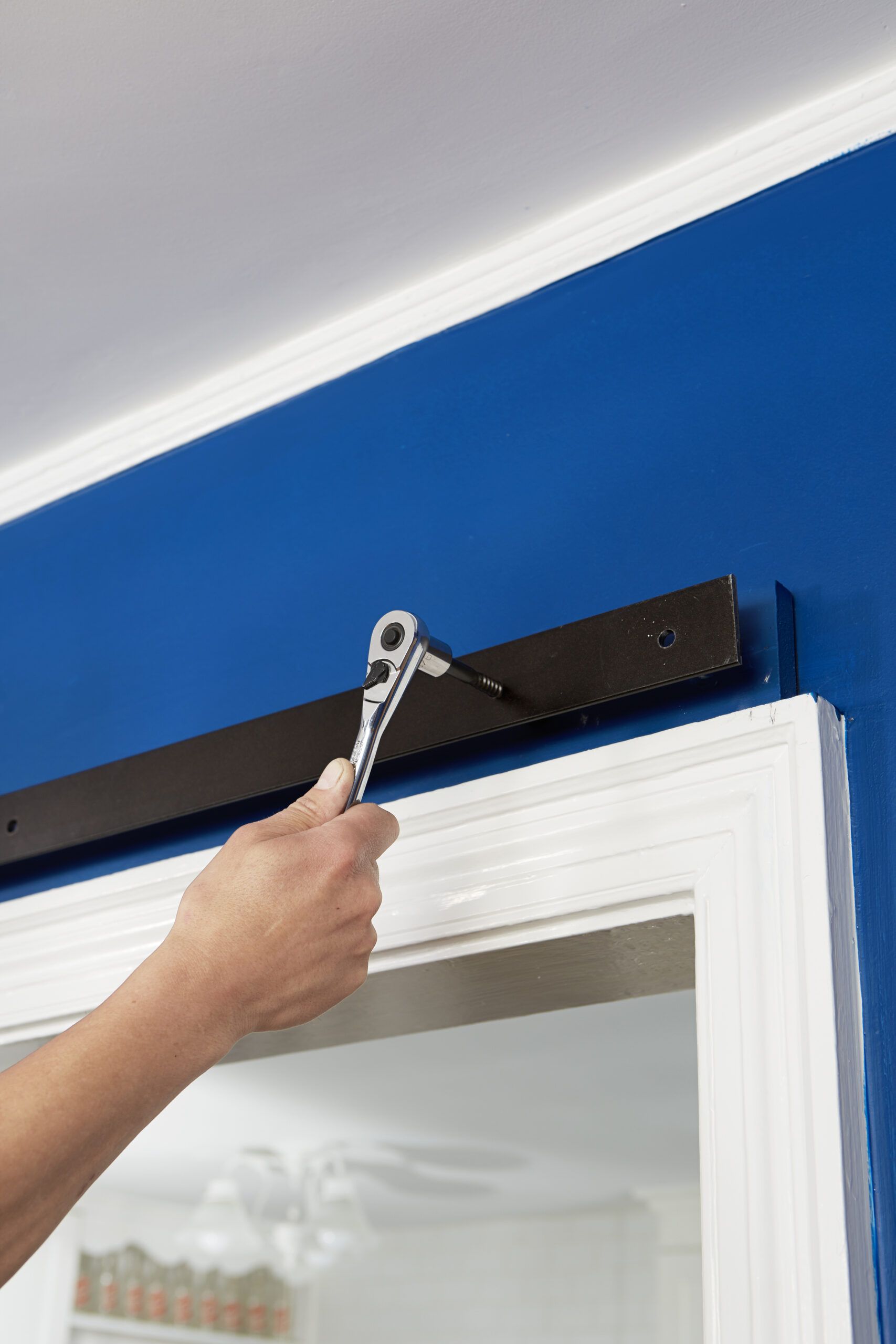
- Measure 3/4 inch above the casing and mark two spots on the mounting board.
- Hold the track flat against the board, with its bottom edge at the marks.
- Using a 2-foot level, check that it’s level, then mark each lag bolt location on the board.
- Set the track aside and drill 5/16-inch pilot holes at each mark.
- Thread a lag screw through one hole and a standoff and tighten it—not all the way—using a 3/8-inch socket wrench.
- Ratchet the rest of the lags in place, then go back and snug them all up.
Step 13: Roll the Door On
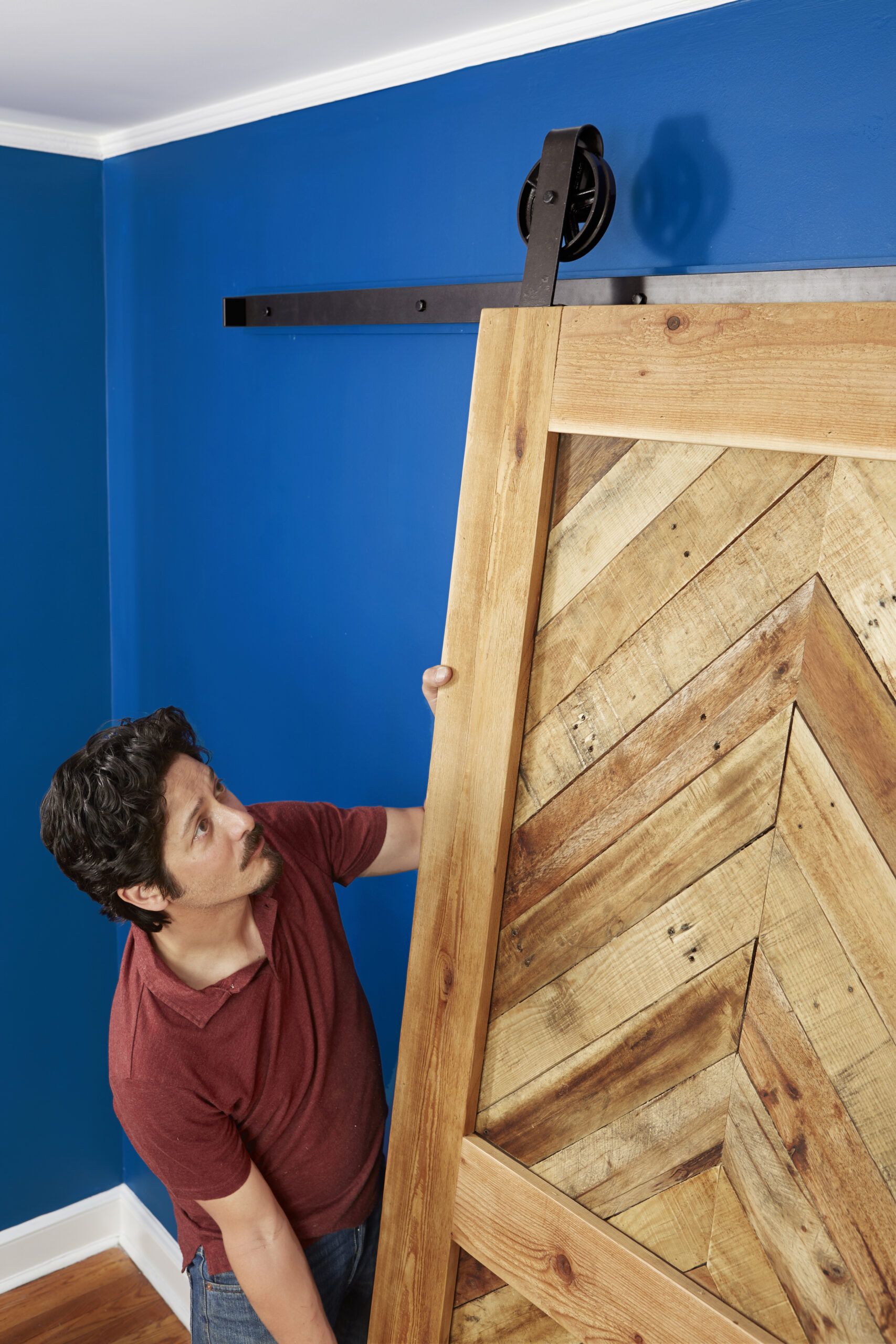
- Install a doorstop at one end.
- With a helper, hoist the door onto the track and slide it to the doorstop.
- Install the other doorstop.
- Position the L-shaped floor guide so that it contains the door in both its open and closed positions.
- Mark the screw locations, drill pilot holes, and secure the guide to the floor with the included screws.
- Position the door handle on the centerline of the stile, drill 1/8-inch pilot holes, and secure it with the included hardware.
Additional Considerations
When building and installing a sliding barn door, you should also keep in mind the following considerations:
- Finishing options: Beyond paste wax, you can stain or paint the door to match your interior decor.
- Hardware quality: Invest in good-quality sliding mechanisms. Cheap hardware can affect the door’s performance.
- Measurement accuracy: Double-check all measurements to ensure smooth assembly and operation.
- Safety first: Always wear safety goggles and ear protection when using power tools.
- Wood selection: Choose high-quality wood to ensure durability and a polished final appearance.









